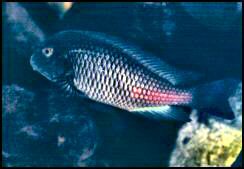



![]() .Tropheus
sp."Rutungu"
.Tropheus
sp."Rutungu"
![]() Tropheus moorii Chipimbe.
Tropheus moorii Chipimbe.
![]() Tropheus
moorii
Tropheus
moorii
Tropheus moorii Staartstreep rood ![]()
Tropheus moorii regenboog oranje ![]()




   | ||
| | ||
 |
|
|
|
|
|
|
|
Tropheus
moorii (Boulenger 1898) We start with a portrait of Tropheus moorii. After all Tropheus moorii is the Tropheus that has been described first and that is known for the longest time, obvious that it is typusspecimen for the genus and serves as reference material for the specimen of the genus that were described later on. Picturede at the top on the left. Aquarist know the animal as the "Brabantmoorii". The medium length of the mature moorii's in the lake come to 200 mm So it is a medium sized cichlid. It has a stocky and torpedo shape body with powerful fins. That enables it to move rapidly between the rocks to avoid enemies by quick turns and to make a quick start. It is not in the least a swimmer for the long distances. The De tropheus specimen are all bound to the littoral zone. The Tropheus moorii by nature is as all the other Tropheuses an eater of algae and a mouthbreeder. In the wide, crosswise placed, distinct inferior mouth are spatula-shaped tooth; suitable to graze the stones bare of these algae. They occur in extended groups that clearly are grouped in a pattern of an order of ranking. In the aquarium one better combines some males with a number females as large as the measurement of the aquarium permit and perhaps also as much as our financial situation enables. The aggression of Tropheus moorii is known and therefor it is very difficult, perhaps impossible to introduce new specimen in a group that has already formed itself. It is wise to purchase from the beginning a group off sufficient size. Addition of the group can also take place by maintaining carefully selected young ones. | Tropheus
duboisi (Marlier 1959) |